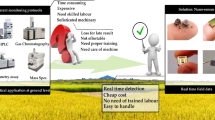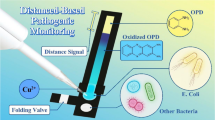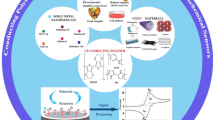Abstract
Excessive copper (as Cu(II)) in drinking water—in place through mining, farming, manufacturing operations, and municipal or industrial wastewater releases—can be a threat to human health and ecosystem wellbeing. Some sources of drinking water are remote; hence, the sensitive, selective, and portable detection of contaminated copper in drinking water sources is of great importance. Through this work, a portable fabric amperometric nanosensor has been devised via a simple dip-coating method, which is able to rapidly, sensitively, and selectively detect Cu(II) ions in a range of 0.65 to 39 ppm in real time. The prepared Cu(II) nanosensor, which operates under a low voltage, consists of three layers: electrospun nylon-6 nanofibers, multi-walled carbon nanotubes, and 2,2′:5′,2″-terthiophene molecules. Potential interfering metal ions, including Cd(II), Fe(II), Pb(II), Hg(II), and Ag(I) ions, have no significant influence on the response of the Cu(II) nanosensor. This fabric sensor—that is able to be placed in your pocket and carried about—is more portable than current technologies, while being able to detect Cu(II) on the same level necessary for potable water. We anticipate our nanosensor to be a starting point for more sophisticated and comprehensive heavy metal assay. Furthermore, this nanosensor will aid in on-site detection of Cu(II) in potential drinking water sources, lending itself well to third world and remote detection.

A polymer nanocomposite sensor has been developed for the sensitive and selective detection of copper in water.





Similar content being viewed by others
References
C. f. D. C. a. Prevention. Copper and drinking water from private wells. cdc.gov. https://www.cdc.gov/healthywater/drinking/private/wells/disease/copper.html. Accessed 2017
Mukherjee S, Talukder S, Chowdhury S, Mal P, Stoeckli-Evans H (2016) Synthesis, structure and sensing behavior of hydrazone based chromogenic chemosensors for Cu2+ in aqueous environment. Inorg Chim Acta 450:216–224. https://doi.org/10.1016/j.ica.2016.05.049
Lv L, Diao Q (May 15 2017) A highly selective and sensitive rhodamine-derived fluorescent probe for detection of Cu2+. Spectrochim Acta A Mol Biomol Spectrosc 179:221–226. https://doi.org/10.1016/j.saa.2017.02.053
Wang S et al (2017) The triple roles of glutathione for a DNA-cleaving DNAzyme and development of a fluorescent glutathione/Cu2+-dependent DNAzyme sensor for detection of Cu2+ in drinking water. ACS Sens 2(3):364–370. https://doi.org/10.1021/acssensors.6b00667
Zong L, Song Y, Li Q, Li Z (2016) A “turn-on” fluorescence probe towards copper ions based on core-substituted naphthalene diimide. Sensors Actuators B Chem 226:239–244. https://doi.org/10.1016/j.snb.2015.11.089
He Y et al (2016) Phosphatidylserine-functionalized Fe3O4@SiO2 nanoparticles combined with enzyme-encapsulated liposomes for the visual detection of Cu2+. J Mater Chem B 4(4):752–759. https://doi.org/10.1039/c5tb01926e
Gedda G, Lee C-Y, Lin Y-C, Wu H-F (2016) Green synthesis of carbon dots from prawn shells for highly selective and sensitive detection of copper ions. Sensors Actuators B Chem 224:396–403. https://doi.org/10.1016/j.snb.2015.09.065
Su Y et al (2016) Facile preparation of fluorescent polydihydroxyphenylalanine nanoparticles for label-free detection of copper ions. Sensors Actuators B Chem 225:334–339. https://doi.org/10.1016/j.snb.2015.11.067
Xiong J-J, Huang P-C, Zhou X, Wu F-Y (2016) A highly selective and sensitive “turn-on” fluorescent probe of Cu2+ by p-dimethylaminobenzamide-based derivative and its bioimaging in living cells. Sensors Actuators B Chem 232:673–679. https://doi.org/10.1016/j.snb.2016.04.004
Gao W et al (2016) Wearable microsensor array for multiplexed heavy metal monitoring of body fluids. ACS Sens 1(7):866–874. https://doi.org/10.1021/acssensors.6b00287
Huang J, Zheng Q, Kim JK, Li Z (2013) A molecular beacon and graphene oxide-based fluorescent biosensor for Cu2+ detection. Biosens Bioelectron 43:379–383. https://doi.org/10.1016/j.bios.2012.12.056
Pihlasalo S, Perez IM, Hollo N, Hokkanen E, Pahikkala T, Harma H (2016) Luminometric label array for quantification and identification of metal ions. Anal Chem 88(10):5271–5280. https://doi.org/10.1021/acs.analchem.6b00453
Kang JH, Lee SY, Ahn HM, Kim C (2016) Sequential detection of copper(II) and cyanide by a simple colorimetric chemosensor. Inorg Chem Commun 74:62–65. https://doi.org/10.1016/j.inoche.2016.10.039
Rezaeian K, Khanmohammadi H, Arab V (Dec 05 2015) Rational design of a novel azoimine appended maleonitrile-based Salen chemosensor for rapid naked-eye detection of copper(II) ion in aqueous media. Spectrochim Acta A Mol Biomol Spectrosc 151:848–853. https://doi.org/10.1016/j.saa.2015.06.127
Zhang H et al (2015) Coupling a novel spiro-rhodamine B lactam derivative to Fe3O4 nanoparticles for visual detection of free copper ions with high sensitivity and specificity. RSC Adv 5(57):45847–45852. https://doi.org/10.1039/c5ra04272k
Wujcik EK, Duirk SE, Chase GG, Monty CN (2016) A visible colorimetric sensor based on nanoporous polypropylene fiber membranes for the determination of trihalomethanes in treated drinking water. Sensors Actuators B Chem 223:1–8. https://doi.org/10.1016/j.snb.2015.09.004
Zhang B, Diao Q, Ma P, Liu X, Song D, Wang X (2016) A sensitive fluorescent probe for Cu2+ based on rhodamine B derivatives and its application to drinking water examination and living cells imaging. Sensors Actuators B Chem 225:579–585. https://doi.org/10.1016/j.snb.2015.11.069
Huang P-C, Fang H, Xiong J-J, Wu F-Y (2017) Ultrasensitive turn-on fluorescence detection of Cu2+ based on p-dimethylaminobenzamide derivative and the application to cell imaging. Spectrochim Acta A Mol Biomol Spectrosc 173:264–269. https://doi.org/10.1016/j.saa.2016.09.011
Shanmugaraj K, Ilanchelian M (2016) A “turn-off” fluorescent sensor for the selective and sensitive detection of copper(II) ions using lysozyme stabilized gold nanoclusters. RSC Adv 6(59):54518–54524. https://doi.org/10.1039/c6ra08325k
Khan B et al (2016) Synthesis, characterization and Cu2+ triggered selective fluorescence quenching of bis-calix[4]arene tetra-triazole macrocycle. J Hazard Mater 309:97–106. https://doi.org/10.1016/j.jhazmat.2016.01.074
Vopalenska I, Vachova L, Palkova Z (2015) New biosensor for detection of copper ions in water based on immobilized genetically modified yeast cells. Biosens Bioelectron 72:160–167. https://doi.org/10.1016/j.bios.2015.05.006
Wang R, Wang W, Ren H, Chae J (2014) Detection of copper ions in drinking water using the competitive adsorption of proteins. Biosens Bioelectron 57:179–185. https://doi.org/10.1016/j.bios.2014.01.056
Yin K, Wu Y, Wang S, Chen L (2016) A sensitive fluorescent biosensor for the detection of copper ion inspired by biological recognition element pyoverdine. Sensors Actuators B Chem 232:257–263. https://doi.org/10.1016/j.snb.2016.03.128
Zhang W et al (2012) Self-assembled multilayer of alkyl graphene oxide for highly selective detection of copper(II) based on anodic stripping voltammetry. J Mater Chem 22(42):22631–22636. https://doi.org/10.1039/c2jm34795d
Sun Y-F, Zhao L-J, Jiang T-J, Li S-S, Yang M, Huang X-J (2016) Sensitive and selective electrochemical detection of heavy metal ions using amino-functionalized carbon microspheres. J Electroanal Chem 760:143–150. https://doi.org/10.1016/j.jelechem.2015.11.028
Li W-J, Yao X-Z, Guo Z, Liu J-H, Huang X-J (2015) Fe3O4 with novel nanoplate-stacked structure: surfactant-free hydrothermal synthesis and application in detection of heavy metal ions. J Electroanal Chem 749:75–82. https://doi.org/10.1016/j.jelechem.2015.04.038
Yuan S, Peng D, Hu X, Gong J (2013) Bifunctional sensor of pentachlorophenol and copper ions based on nanostructured hybrid films of humic acid and exfoliated layered double hydroxide via a facile layer-by-layer assembly. Anal Chim Acta 785:34–42. https://doi.org/10.1016/j.aca.2013.04.050
Xiong S, Ye S, Hu X, Xie F (2016) Electrochemical detection of ultra-trace Cu(II) and interaction mechanism analysis between amine-groups functionalized CoFe2O4/reduced graphene oxide composites and metal ion. Electrochim Acta 217:24–33. https://doi.org/10.1016/j.electacta.2016.09.060
Wang S, Wang Y, Zhou L, Li J, Wang S, Liu H (2014) Fabrication of an effective electrochemical platform based on graphene and AuNPs for high sensitive detection of trace Cu2+. Electrochim Acta 132:7–14. https://doi.org/10.1016/j.electacta.2014.03.114
Soleimani M, Afshar MG (2013) Potentiometric sensor for trace level analysis of copper based on carbon paste electrode modified with multi-walled carbon nanotubes. Int J Electrochem Sci 8:8719–8729
Baig U, Khan AA (2015) Polyurethane-based cation exchange composite membranes: preparation, characterization and its application in development of ion-selective electrode for detection of copper(II). J Ind Eng Chem 29:392–399. https://doi.org/10.1016/j.jiec.2014.12.045
Ali TA, Eldidamony AM, Mohamed GG, Elatfy DM (2014) Construction of chemically modified electrode for the selective determination of copper(II) ions in polluted water samples based on new β-cyclodextrine and 1,4-bis(6-bromohexyloxy)benzene ionophores. Int J Electrochem Sci 9:2420–2434
Mahajan RK, Sood P (2007) Novel copper(II)-selective electrode based on 2,2′:5′,2″-terthiophene in PVC matrix. Int J Electrochem Sci 2:832–847
Wujcik EK, Blasdel NJ, Trowbridge D, Monty CN (2013) Ion sensor for the quantification of sodium in sweat samples. IEEE Sensors J 13(9):3430–3436. https://doi.org/10.1109/jsen.2013.2257168
Lala NL, Thavasi V, Ramakrishna S (2009) Preparation of surface adsorbed and impregnated multi-walled carbon nanotube/nylon-6 nanofiber composites and investigation of their gas sensing ability. Sensors 9(1):86–101. https://doi.org/10.3390/s90100086
Monty CN, Wujcik EK, Blasdel NJ (2017) Flexible electrode for detecting changes in temperature, humidity, and sodium ion concentration in sweat. USA Patent US 9,603,560 B2 Patent Appl. 61/590,839
El-Newehy MH, Al-Deyab SS, Kenawy E-R, Abdel-Megeed A (2011) Nanospider technology for the production of nylon-6 nanofibers for biomedical applications. J Nanomater 2011:1–8. https://doi.org/10.1155/2011/626589
Mahajan A, Kingon A, Kukovecz Á, Konya Z, Vilarinho PM (2013) Studies on the thermal decomposition of multiwall carbon nanotubes under different atmospheres. Mater Lett 90:165–168
Zhang Q et al (2002) Thermal conductivity of multiwalled carbon nanotubes. Phys Rev B 66(16):165440
Chen G-X, Kim H-S, Park BH, Yoon J-S (2006) Multi-walled carbon nanotubes reinforced nylon 6 composites. Polymer 47(13):4760–4767
Choi J, Park DW, Shim SE (2011) Chemical vapour sensing behaviors of multi-walled carbon nanotube adsorbed electrospun nylon 6,6 nanofibers. Macromol Res 19(9):980–983. https://doi.org/10.1007/s13233-011-0905-x
Yin B, Jiang C, Wang Y, La M, Liu P, Deng W (2010) Synthesis and electrochromic properties of oligothiophene derivatives. Synth Met 160(5–6):432–435. https://doi.org/10.1016/j.synthmet.2009.11.025
Generali G, Capelli R, Toffanin S, Facchetti A, Muccini M (2010) Ambipolar field-effect transistor based on α,ω-dihexylquaterthiophene and α,ω-diperfluoroquaterthiophene vertical heterojunction. Microelectron Reliab 50(9–11):1861–1865. https://doi.org/10.1016/j.microrel.2010.07.047
Pappenfus TM et al (2002) A π-stacking terthiophene-based quinodimethane is an n-channel conductor in a thin film transistor. J Am Chem Soc 124(16):4184–4185
Acknowledgments
This work was supported by The University of Alabama College of Engineering.
Funding
This work was financially supported by the Texas Hazardous Waste Research Center [THWRC].
Author information
Authors and Affiliations
Corresponding author
Ethics declarations
Conflict of interest
The authors declare that they have no conflict of interest.
Additional information
Publisher’s note
Springer Nature remains neutral with regard to jurisdictional claims in published maps and institutional affiliations.
Electronic supplementary material
ESM 1
(DOCX 86 kb)
Rights and permissions
About this article
Cite this article
Lu, Y., Yu, G., Wei, X. et al. Fabric/multi-walled carbon nanotube sensor for portable on-site copper detection in water. Adv Compos Hybrid Mater 2, 711–719 (2019). https://doi.org/10.1007/s42114-019-00122-7
Received:
Revised:
Accepted:
Published:
Issue Date:
DOI: https://doi.org/10.1007/s42114-019-00122-7




